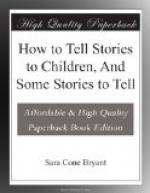From the very start, the mood of the tale should be definite and authoritative, beginning with the mood of the teller and emanating therefrom in proportion as the physique of the teller is a responsive medium.
Now we are off. Knowing your story, having your hearers well arranged, and being as thoroughly as you are able in the right mood, you begin to tell it. Tell it, then, simply, directly, dramatically, with zest.
Simply applies both to manner and matter. As to manner, I mean without affectation, without any form of pretence, in short, without posing. It is a pity to “talk down” to the children, to assume a honeyed voice, to think of the edifying or educational value of the work one is doing. Naturalness, being oneself, is the desideratum. I wonder why we so often use a preposterous voice,—a super-sweetened whine, in talking to children? Is it that the effort to realise an ideal of gentleness and affectionateness overreaches itself in this form of the grotesque? Some good intention must be the root of it. But the thing is none the less pernicious. A “cant” voice is as abominable as a cant phraseology. Both are of the very substance of evil.
“But it is easier to say, ‘Be natural’ than to be it,” said one teacher to me desperately.
Beyond dispute. To those of us who are cursed with an over-abundant measure of self-consciousness, nothing is harder than simple naturalness. The remedy is to lose oneself in one’s art. Think of the story so absorbingly and vividly that you have no room to think of yourself. Live it. Sink yourself in that mood you have summoned up, and let it carry you.
If you do this, simplicity of matter will come easily. Your choice of words and images will naturally become simple.
It is, I think, a familiar precept to educators, that children should not have their literature too much simplified for them. We are told that they like something beyond them, and that it is good for them to have a sense of mystery and power beyond the sense they grasp. That may be true; but if so it does not apply to story-telling as it does to reading. We have constantly to remember that the movement of a story told is very swift. A concept not grasped in passing is irrevocably lost; there is no possibility of turning back, or lingering over the page. Also, since the art of story-telling is primarily an art of entertainment, its very object is sacrificed if the ideas and images do not slip into the child’s consciousness smoothly enough to avoid the sense of strain. For this reason short, familiar, vivid words are best.
Simplicity of manner and of matter are both essential to the right appeal to children.
Directness in telling is a most important quality. The story, listened to, is like the drama, beheld. Its movement must be unimpeded, increasingly swift, winding up “with a snap.” Long-windedness, or talking round the story, utterly destroys this movement. The incidents should be told, one after another, without explanation or description beyond what is absolutely necessary; and they should be told in logical sequence. Nothing is more distressing than the cart-before-the-horse method,—nothing more quickly destroys interest than the failure to get a clue in the right place.




